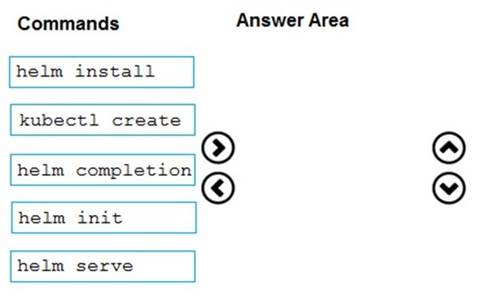- (Topic 4)
You have a GitHub repository.
You create a new repository in Azure DevOps.
You need to recommend a procedure to clone the repository from GitHub to Azure DevOps.
What should you recommend?
Correct Answer:
D
You can import an existing Git repo from GitHub, Bitbucket, GitLab, or other location into a new or empty existing repo in your project in Azure DevOps.
Import into a new repo
✑ Select Repos, Files.
✑ From the repo drop-down, select Import repository.
✑ If the source repo is publicly available, just enter the clone URL of the source repository and a name for your new Git repository.
References:
https://docs.microsoft.com/en-us/azure/devops/repos/git/import-git-repository?view=azure- devops
- (Topic 4)
You have an application that consists of several Azure App Service web apps and Azure functions.
You need to access the security of the web apps and the functions.
Which Azure features can you use to provide a recommendation for the security of the application?
Correct Answer:
D
Monitor compute and app services: Compute & apps include the App Services tab, which App services: list of your App service environments and current security state of each.
Recommendations
This section has a set of recommendations for each VM and computer, web and worker roles, Azure App Service Web Apps, and Azure App Service Environment that Security
Center monitors. The first column lists the recommendation. The second column shows the total number of resources that are affected by that recommendation. The third column shows the severity of the issue.
DRAG DROP - (Topic 4)
You provision an Azure Kubernetes Service (AKS) cluster that has RBAC enabled. You have a Helm chart for a client application.
You need to configure Helm and Tiller on the cluster and install the chart.
Which three commands should you recommend be run in sequence? To answer, move the appropriate commands from the list of commands to the answer area and arrange them in the correct order.
Solution:
Step 1: Kubectl create
You can add a service account to Tiller using the --service-account
Example: Service account with cluster-admin role
$ kubectl create -f rbac-config.yaml serviceaccount "tiller" created clusterrolebinding "tiller" created
$ helm init --service-account tiller
Step 2: helm init
To deploy a basic Tiller into an AKS cluster, use the helm init command.
Step 3: helm install
To install charts with Helm, use the helm install command and specify the name of the chart to install.
References:
https://docs.microsoft.com/en-us/azure/aks/kubernetes-helm https://docs.helm.sh/using_helm/#tiller-namespaces-and-rbac
Does this meet the goal?
Correct Answer:
A
DRAG DROP - (Topic 4)
You are defining release strategies for two applications as shown in the following table.
Which release strategy should you use for each application? To answer, drag the
appropriate release strategies to the correct applications. Each release strategy may be used once, more than once, or not at all. You may need to drag the split bar between panes or scroll to view content.
NOTE: Each correct selection is worth one point.
Solution:
App1: Canary deployment
With canary deployment, you deploy a new application code in a small part of the production infrastructure. Once the application is signed off for release, only a few users
are routed to it. This minimizes any impact.
With no errors reported, the new version can gradually roll out to the rest of the infrastructure.
App2: Rolling deployment:
In a rolling deployment, an application’s new version gradually replaces the old one. The actual deployment happens over a period of time. During that time, new and old versions will coexist without affecting functionality or user experience. This process makes it easier to roll back any new component incompatible with the old components.
Does this meet the goal?
Correct Answer:
A
- (Topic 4)
Your company has an on-premises Bitbucket Server that is used for Git-based source control. The server is protected by a firewall that blocks inbound Internet traffic.
You plan to use Azure DevOps to manage the build and release processes Which two components are required to integrate Azure DevOps and Bitbucket? Each correct answer presents part of the solution.
NOTE: Each correct selection is worth one port.
Correct Answer:
AD
When a pipeline uses a remote, 3rd-party repository host such as Bitbucket Cloud, the repository is configured with webooks that notify Azure Pipelines Server or TFS when code has changed and a build should be triggered. Since on-premises installations are normally protected behind a firewall, 3rd-party webhooks are unable to reach the on- premises server. As a workaround, you can use the External Git repository type which uses polling instead of webhooks to trigger a build when code has changed.
References: https://docs.microsoft.com/en-us/azure/devops/pipelines/repos/pipeline- options-for

